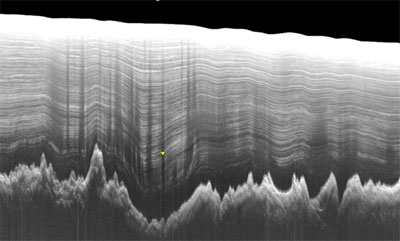Insights into the Evolution of the Antarctic Ice Sheet from Aerogeophysics
By:
Duncan Young
UTIG
| When: | Friday, March 1, 2013, 10:30 a.m. to 11:30 a.m. Join us for coffee beginning at 10:00 a.m. |
| Where: | Seminar Conference Room, 10100 Burnet Road, Bldg 196-ROC, Austin, Texas 78758 |
| Host: | Don Blankenship, UTIG |
Click for a Live Broadcast.
Abstract
 The glaciation of the Antarctic has played a crucial role in shaping the 'icehouse' world that humans arose in, and may play an important role in our future. Ice sheets have a significant impact on sea level variability, as well as ocean and atmospheric circulation variability on evolutionary time scales. The underlying geology and geomorphology of the Antarctic continent, (which can be inferred from airborne observations) both played a critical role in shaping ice sheets, and represents a record of their evolution.
While the idea of greenhouse-icehouse transition in Earth's climate during the Cenozoic is well established, ocean records imply several paradoxes related to ice volume that must be reconciled to understand how we got to our modern climate regime. Going forward into a world with 'greenhouse' levels of carbon dioxide, we must understand which lessons from the past climate transition apply to current climate change given ice sheet hysteresis and very different rates of change on forcing.
New aerogeophysical data from East and West Antarctica combining radar sounding, magnetics, gravity, and altimetry elucidate the geology of the Antarctic continent, and thus help constrain the geometry of ice sheet change over the Cenozoic. We focus on East Antarctica's Aurora and the Wilkes Subglacial Basins and the constraints they offer on the Cenozoic evolution of the ice sheet margin, as well as new data in West Antarctica that help reconcile the history of that vulnerable ice sheet.
The glaciation of the Antarctic has played a crucial role in shaping the 'icehouse' world that humans arose in, and may play an important role in our future. Ice sheets have a significant impact on sea level variability, as well as ocean and atmospheric circulation variability on evolutionary time scales. The underlying geology and geomorphology of the Antarctic continent, (which can be inferred from airborne observations) both played a critical role in shaping ice sheets, and represents a record of their evolution.
While the idea of greenhouse-icehouse transition in Earth's climate during the Cenozoic is well established, ocean records imply several paradoxes related to ice volume that must be reconciled to understand how we got to our modern climate regime. Going forward into a world with 'greenhouse' levels of carbon dioxide, we must understand which lessons from the past climate transition apply to current climate change given ice sheet hysteresis and very different rates of change on forcing.
New aerogeophysical data from East and West Antarctica combining radar sounding, magnetics, gravity, and altimetry elucidate the geology of the Antarctic continent, and thus help constrain the geometry of ice sheet change over the Cenozoic. We focus on East Antarctica's Aurora and the Wilkes Subglacial Basins and the constraints they offer on the Cenozoic evolution of the ice sheet margin, as well as new data in West Antarctica that help reconcile the history of that vulnerable ice sheet.




